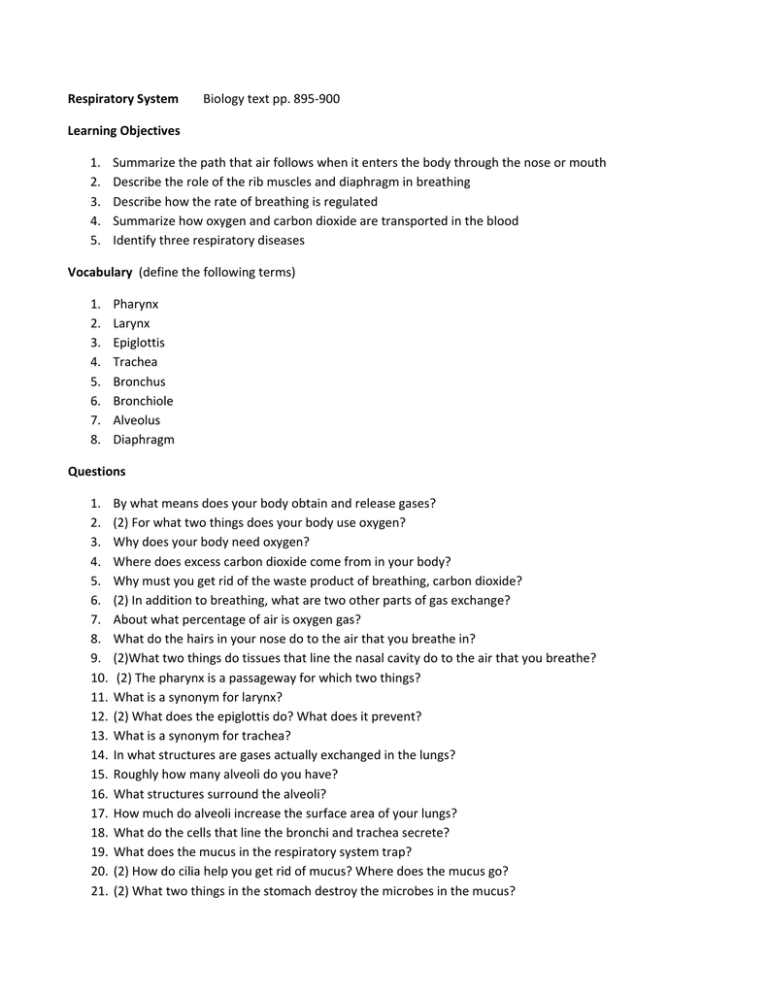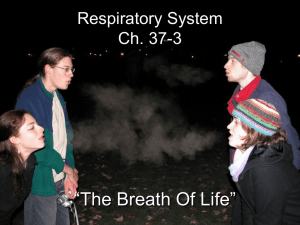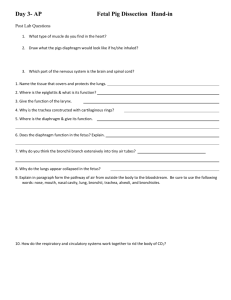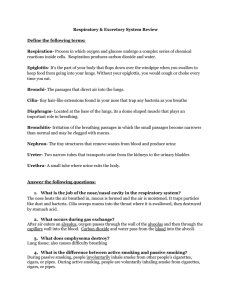Respiratory System Learning Objectives Biology text pp. 895‐900 1. Summarize the path that air follows when it enters the body through the nose or mouth
advertisement

Respiratory System Biology text pp. 895‐900 Learning Objectives 1. 2. 3. 4. 5. Summarize the path that air follows when it enters the body through the nose or mouth Describe the role of the rib muscles and diaphragm in breathing Describe how the rate of breathing is regulated Summarize how oxygen and carbon dioxide are transported in the blood Identify three respiratory diseases Vocabulary (define the following terms) 1. 2. 3. 4. 5. 6. 7. 8. Pharynx Larynx Epiglottis Trachea Bronchus Bronchiole Alveolus Diaphragm Questions 1. 2. 3. 4. 5. 6. 7. 8. 9. 10. 11. 12. 13. 14. 15. 16. 17. 18. 19. 20. 21. By what means does your body obtain and release gases? (2) For what two things does your body use oxygen? Why does your body need oxygen? Where does excess carbon dioxide come from in your body? Why must you get rid of the waste product of breathing, carbon dioxide? (2) In addition to breathing, what are two other parts of gas exchange? About what percentage of air is oxygen gas? What do the hairs in your nose do to the air that you breathe in? (2)What two things do tissues that line the nasal cavity do to the air that you breathe? (2) The pharynx is a passageway for which two things? What is a synonym for larynx? (2) What does the epiglottis do? What does it prevent? What is a synonym for trachea? In what structures are gases actually exchanged in the lungs? Roughly how many alveoli do you have? What structures surround the alveoli? How much do alveoli increase the surface area of your lungs? What do the cells that line the bronchi and trachea secrete? What does the mucus in the respiratory system trap? (2) How do cilia help you get rid of mucus? Where does the mucus go? (2) What two things in the stomach destroy the microbes in the mucus? 22. 23. 24. 25. 26. 27. 28. 29. 30. 31. 32. 33. 34. 35. 36. 37. 38. 39. 40. What structures protect the lungs in the chest cavity? What does the diaphragm do? (2) How many membranes surround the lungs? What fills the spaced between these membranes? What causes breathing? (2) What are hiccups and what causes them? (2) During inhalation, does the diaphragm contract or relax? Does it move up or down? During inhalation, air moves into the lungs because air pressure inside the lungs becomes _____ than the air pressure outside the lungs. (2) During exhalation, does the diaphragm contract or relax? Is exhalation an active or passive process? During exhalation, air pressure inside the lungs becomes _____ than air pressure outside the lungs, so the air moves out of the lungs. High ______________________ levels in the body cause a person to breathe more deeply. Oxygen diffuses from the air into your ______________. Oxygen is picked up by __________________ , a protein molecule which carries oxygen through the blood to all cells in the body. Oxygen Transport= A. _____________ moves into the lungs. B. O2 from alveoli → ______________ where it is carried by _______________ molecules in RBCs (red blood cells). C. Oxygen‐rich blood → __________________ → body tissues D. O2 → cells via __________________(a process) E. ____________ from cells → blood , via diffusion F. __________________ pumps blood to _________ G. CO2 diffuses from capillaries into the __________________ of the lungs. H. ___________ leaves the body via exhalation. Asthma causes the bronchioles to _______________, which reduces the air flow to the lungs. ______________________ and _____________________ may trigger an asthma attack. Emphysema damages the ____________ of the lungs, causing the patient to suffer from constant _________________ and breathlessness. ___________________ and _______________________ often result from cigarette smoking. _______________________ is one of the leading causes of death in the world today. Fewer than ____________ percent of lung cancer live more than ______ years after diagnosis.






